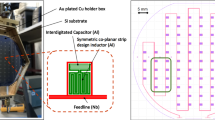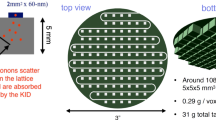Abstract
We present a status update on the development of a phonon-mediated particle detector using kinetic inductance detector (KID). The design is intended for \(\mathscr {O}(1)\) kg substrate, using \(\mathscr {O}(10^{2})\) KIDs on a single readout line, to image the athermal phonon distribution at < 1 mm position resolution and \(\mathscr {O}(10)\) eV energy resolution. The design specification is set by the need to improve position reconstruction fidelity while maintaining low energy threshold for future rare-event searches such as for low-mass dark matter. We report on the design, which shows negligible crosstalk and > 95% inductor current uniformity, using the coplanar waveguide feedline, ground shield, and a new class of KIDs with symmetric coplanar stripline (sCPS) inductor. The multiplexing is designed upon the frequency-geometry relation we develop for the sCPS KIDs. We introduce the fabrications of the Nb RF assessment prototypes and the high phonon collection efficiency Al–Nb devices. We achieve \(\lesssim \) 0.07% frequency displacement on a 80-KID RF assessment prototype, and the result indicates that we may place more than 180 resonances in our 0.4 GHz readout band with minimal frequency misordering. The coupling quality factors are \(\sim \) 10\(^{5}\) as designed. Finally, we update our work in progress in fabricating the \(\mathscr {O}(10^{2})\) KID, bi-material, \(\mathscr {O}(1)\) kg detectors, and the expected position and energy resolutions.




Similar content being viewed by others
References
P.K. Day et al., Nature 425, 817 (2003). https://doi.org/10.1038/nature02037
D.C. Moore et al., Appl. Phys. Lett. 100, 232601 (2012). https://doi.org/10.1063/1.4726279
L. Cordani et al., Appl. Phys. Lett. 110, 033504 (2017). https://doi.org/10.1063/1.4974082
O. Noroozian et al., IEEE Trans. Microw. Theory Tech. 60(5), 1235 (2012). https://doi.org/10.1109/TMTT.2012.2187538
E.S. Battistelli et al., Eur. Phys. J. C75 8, 353 (2015). https://doi.org/10.1140/epjc/s10052-015-3575-6
J. Gao, Dissertation (Ph.D.), California Institute of Technology (2008)
Acknowledgements
This work is supported by the Department of Energy (Contract No. DE-SC0013881), and the devices used were fabricated at the Jet Propulsion Laboratory, California Institute of Technology, under a contract with the National Aeronautic and Space Administration. The authors would also like to thank Matthew Hollister for the great help in cryogenic systems, and Peter Day, Andrew Beyer, Roger O’Brient, Anthony Turner, and members of Mazin Lab at UCSB for helpful discussions.
Author information
Authors and Affiliations
Corresponding author
Rights and permissions
About this article
Cite this article
Chang, YY., Cornell, B., Aralis, T. et al. Development of a Massive, Highly Multiplexible, Phonon-Mediated Particle Detector Using Kinetic Inductance Detectors. J Low Temp Phys 193, 1199–1205 (2018). https://doi.org/10.1007/s10909-018-1900-9
Received:
Accepted:
Published:
Issue Date:
DOI: https://doi.org/10.1007/s10909-018-1900-9




